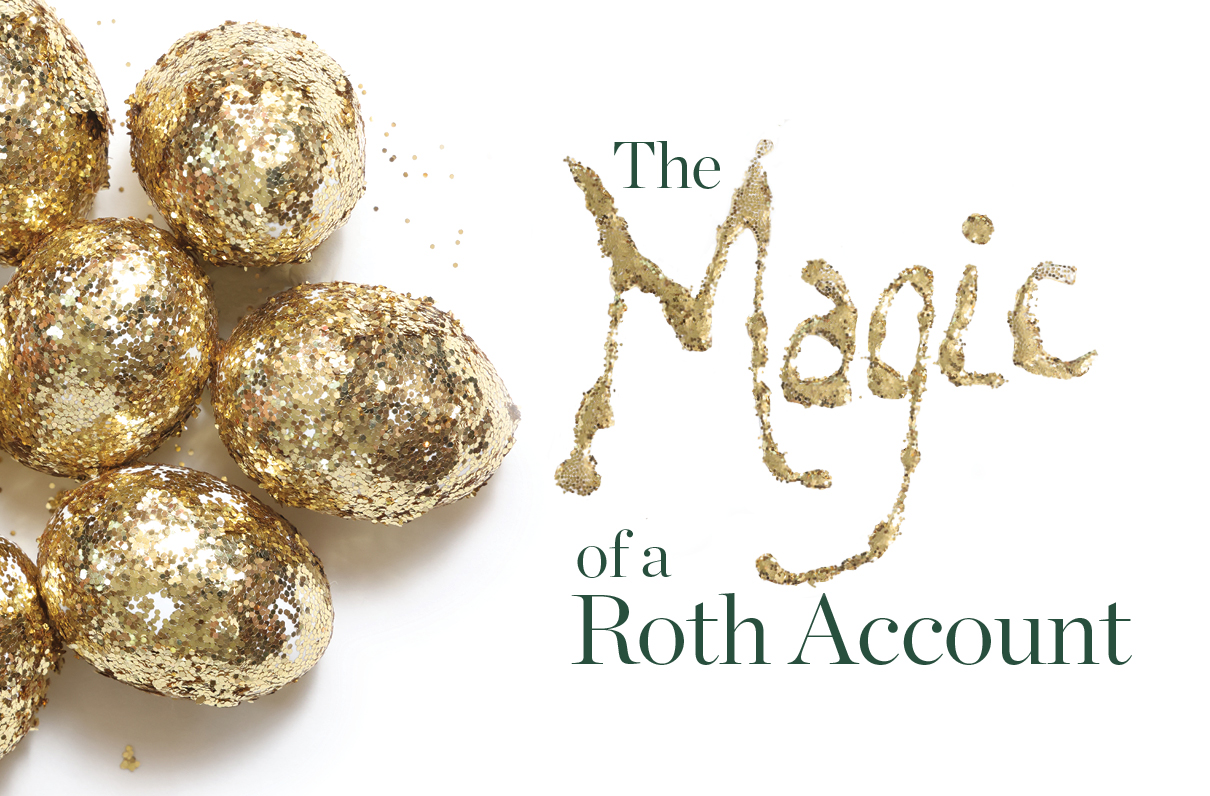(This article originally appeared in the October 2022 issue of Military Officer, a magazine available to all MOAA Premium and Life members. Learn more about the magazine here; learn more about joining MOAA here.)
What if someone told you that you could save for retirement using a vehicle where the money could grow tax-free, you never had to withdraw any of the money if you didn’t want to, and when you did tap the account, you could take money out without paying any tax?
It almost seems too good to be true.
But in fact, Roth accounts allow you to do all of that. Having Roth savings can provide you flexibility in various stages of life, particularly in retirement. When you put money into a Roth account, you pay tax on that money first — essentially buying out Uncle Sam’s partnership in your retirement savings. Then the after-tax money in the Roth can grow tax-free to create a pot of wealth that is all your own; it can even become a tax-free legacy to pass on to heirs.
“The main reason to use a Roth is to get lifetime appreciation that’s not taxed,” said Col. Dr. Steven Podnos, USAFR, CFP®, principal of financial firm Wealth Care.
To fully maximize the benefits of Roth accounts, there are rules you must follow to avoid taxes and penalties. And while Roth accounts are relatively young, having first been available in 1998, there are now a variety of ways to put money into a Roth. The earlier you can put money into a Roth, the better, but even retirees can benefit from stashing money into a Roth. Reaching tax-free nirvana is easier than you might think.
Routes to a Roth
There are two main ways to get money into a Roth: You can do direct contributions to a Roth, and you can convert money to a Roth.
[RELATED: More Financial Resources From MOAA]
You can contribute up to $6,000 (plus $1,000 extra if you are 50 or older) of after-tax money into a Roth IRA for 2022, and you can do the same amount for a nonworking spouse if you have enough earned income to cover both contributions. However, if you make too much money, you may only be able to put in partial contributions, or you may be shut out altogether. For 2022, the income phaseout ranges for Roth contributions are $129,000 to $144,000 of modified adjusted gross income for single filers and $204,000 to $214,000 of MAGI for married couples filing jointly.
There are no income limits for making contributions to a Roth Thrift Savings Plan or other Roth employer account, such as a Roth 401(k). And the amount you can contribute is significantly higher: For 2022, you can stash up to $20,500 in a Roth TSP, plus an extra $6,500 if you are 50 or older. Note: Servicemembers with tax-exempt combat pay can stash that money into a Roth TSP to grow tax-free.
“You can fund both a Roth TSP and a Roth IRA,” said Podnos, depending on whether you meet the Roth IRA contribution income limits.
You can also put money into a Roth account through a conversion. Ask your account custodian to directly roll money from a traditional IRA into a Roth IRA, and when fi ling your tax return, you pay ordinary income tax on the amount of tax-deferred money you convert.
There are no income limits for doing Roth conversions, and it doesn’t matter whether you are working or retired. You can choose to convert as much or as little as you want; just keep in mind that the more you convert, the higher your tax bill can climb.
[RELATED: MOAA's Financial Calculators]
Whether you contribute or convert money to a Roth, a key factor to consider is whether you think your present tax rate is lower than your future tax rate. If you are in your peak earning years, you may be at your highest tax rate — and the tax break you might get now from putting money into a traditional retirement account might be more beneficial for you. If you think your future tax rate will climb compared to your current tax rate, then it may be an ideal time for you to put money into a Roth. (Go to MOAA’s financial calculators page to compare the impact of contributing to a Roth retirement account and a traditional retirement account.)
Consider state taxes, too. If you live in a state that has a state income tax but plan to retire to a state with no income tax, then you might want to hold off putting money in a Roth, said Lt. Col. Kevin Graefe, USAFR (Ret), director of paraplanner services for financial firm Concurrent.
[RELATED: MOAA’s Military State Report Card and Tax Guide]
Smart Conversion Strategies
With Roth conversions limited only by the amount of tax you want to pay, there are some smart strategies to consider. An ideal way to minimize the tax pain is to convert only an amount that takes you up to the top of your current tax bracket, without going into a higher tax bracket.
As the year draws to an end, it gets easier to figure out how much room you might have in your current tax bracket. Using this strategy year after year can help you build up a tax-free pot of money over time while minimizing the tax hit.
When the stock market drops, conversions become particularly attractive because they can help turn market lemons into lemonade. Let’s say you had $50,000 worth of stock in a traditional IRA, and the IRA’s value has dropped 20% to $40,000. If you convert that entire traditional IRA at a 22% tax rate, you save $2,200 in tax by converting at the lower value.
“Ideally, pay the tax with liquid money, not in the IRA,” said former Maj. David Chepauskas, USA, CFP®, senior wealth planner at Summit Financial. In this example, that would allow you to convert the full $40,000 to grow tax-free when the market bounces back. If the Roth IRA grows to, say, $200,000 by the time you reach retirement, all that money is yours.
“A Roth is a great vehicle for investing because qualified distributions are tax-free,” said Graefe.
For those who make too much to contribute to a Roth IRA, consider a “backdoor Roth.” This strategy was on the legislative chopping block last year, but as of press time, “the backdoor Roth is still available,” said Cmdr. Mark Luscombe, USNR (Ret), principal analyst for Wolters Kluwer Tax & Accounting. To use this move, you make nondeductible contributions to an IRA and then convert the money to a Roth IRA. If you do the conversion relatively quickly, the conversion tax bill will be minimal. This move works best if you hold no deductible contributions in your IRAs.
[RELATED: Is a ‘Backdoor Roth IRA’ Right for You?]
Rules for Roth Withdrawals
Once you have money in a Roth, there are some key rules to understand. First, any direct contributions are yours to tap anytime tax- and penalty-free, noted Podnos. To take out earnings from a Roth tax- and penalty-free, you must hold a Roth IRA for at least five years and reach age 59½.
A second five-year rule applies to conversions. For each conversion you do, you must wait at least five years before you can touch that converted amount penalty-free, up until you reach age 59½ when this rule vanishes.
There are ordering rules for Roth withdrawals, which boost their flexibility. When tapping a Roth, contributions are considered to come out first, then converted amounts, and finally earnings. If you contributed $50,000 to a Roth IRA that has grown to $150,000, you can take out $50,000 anytime without incurring taxes or penalties — even if you are younger than 59½ or have held the Roth for less than five years.
Roths for All Life Stages
While Roth IRAs are meant to save for retirement, their flexibility can make them attractive vehicles to save for kids’ education costs or to tap in an emergency. Of course, the more money you can keep in the Roth, the more of it can grow tax-free over time. But if you must use some of the money, it can provide the cash you need without incurring an additional tax bill. Some uses for the money can also qualify for a penalty-free, early-withdrawal exception, such as education costs.
[RELATED: Need Help Juggling Your Family’s Savings Goals?]
In retirement, having a Roth account can provide you flexibility in managing your tax bill. If you have taxable military retirement pay, taxable required minimum distributions from tax-deferred retirement accounts, and taxable Social Security benefits, you can end up with a pretty hefty tax bill. But if you have a significant expense that crops up — say you need a new car or a new roof — tapping your Roth money to cover the expense won’t add to your taxable income.
Working with a financial planner can help you maximize your withdrawal strategy as you tap taxable, tax-deferred, and tax-free sources of retirement income. Having a tax-free pot of money to draw on in retirement may help you lower your adjusted gross income, which in turn can minimize the tax on your Social Security benefits or rein in high-income surcharges on Medicare Part B premiums.
Building a Roth Legacy
While the Roth TSP and Roth 401(k)s have required minimum distributions starting at age 72, Roth IRAs do not have required minimum distributions for the original owner. Avoiding those employer account RMDs is simple: You can roll Roth employer account money into a Roth IRA when you separate from service.
Ideally, open a Roth IRA when you open a Roth employer account because you need to have a Roth IRA open for at least five years for earnings to be tax-free, even if you are older than age 59½. Let’s say you separate from service at age 60 and open your first Roth IRA at that point; you’ll still have to wait five years to tap earnings tax-free, even though you will avoid penalties on withdrawing earnings since you are older than age 59½.
[RELATED: Reducing Taxes After Separating From Service]
With no RMDs, if you don’t need the Roth money, it can just sit and grow tax-free for as long as you like. And when you pass away, the Roth can go to your loved ones as a tax-free legacy.
A surviving spouse who inherits a Roth can choose to take the account as his or her own, and that means the surviving spouse doesn’t have to take RMDs from that Roth account, either.
Unless they are eligible to stretch distributions over their own life expectancies, nonspouse heirs have up to 10 years to withdraw all the money out of the Roth. Either way, they won’t owe any tax when the money comes out.
When a nonspouse heir inherits a traditional IRA, they owe tax as money is withdrawn. If it’s a large account, they could face a very large tax bill, particularly if they are subject to that 10-year window. “The traditional pre-tax retirement plan is generally the least tax-efficient asset to leave to children,” said Chepauskas.
[RELATED: RMD Strategy for a Down Market]
Because of the ability to pass on a tax-free legacy, even an older retiree may want to consider Roth conversions. Let’s say a retiree is age 75 and converts $25,000 to a Roth today. The money grows until the time of his death at age 85, and then goes to his surviving spouse, where the money is left alone and continues to grow until the second spouse’s death 15 years later.
Then, the Roth passes to the couple’s adult child. The nonspouse heir has 10 years to tap the account, but all the money withdrawn will be tax-free. Although the original Roth owner was well into retirement at the time of the conversion, in this example, the account could grow tax-free over 35 years as it is passed down. If the money earns 8% a year, the Roth account would grow to roughly $370,000 by the end of the 35 years. And if the adult child is in a higher tax bracket than the parent was at the time of conversion, the conversion proves even more advantageous.
Doing Double Duty
Retirees may likely consider conversions with heirs in mind. But with odds being good that you or your spouse may live into your 90s, the newly retired may personally reap the benefit from doing a Roth conversion.
Chepauskas illustrates that with an example: Say you retire at age 60 and convert $100,000 from a traditional retirement account to a Roth in the 24% tax bracket. If it grows at 7% a year, he said, by age 90, the power of compounding turns that into about $800,000 tax-free.
While growing in the Roth account, “the money is there if you need it,” he said. In planning for a 30-year retirement, Chepauskas said you could earmark the Roth money for the second half of retirement, starting around age 85, perhaps for long-term care. “You could take out all $800,000 at age 90 tax-free at once if needed.”
If you and your spouse don’t use the Roth money, then it becomes a tax-free legacy for your heirs. “The $24,000 out of pocket can potentially be $800,000 tax-free for heirs,” said Chepauskas. The Roth conversion “could be the single best thing they ever do for their families.”
 Download The MOAA Investor’s Manual
Download The MOAA Investor’s Manual
This guide will help you better understand and manage your investments. It's available exclusively to PREMIUM and LIFE Members, who also may speak with MOAA benefits and financial counselors for further assistance.
Not a member? See below to learn more about joining MOAA or upgrading your membership.

